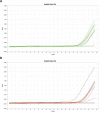Detection of HCV Persistent Infections in the Dental Pulp: A Novel Approach for the Detection of Past and Ancient Infections
- PMID: 27783693
- PMCID: PMC5082628
- DOI: 10.1371/journal.pone.0165272
Detection of HCV Persistent Infections in the Dental Pulp: A Novel Approach for the Detection of Past and Ancient Infections
Abstract
The dental pulp is a sterile highly vascularized tissue and has been commonly used as a biological material to detect the genome of infectious agents that reach the dental tissue. Indeed, the pulp is also used to reveal past and ancient infections in the field of paleomicrobiology. The present study aimed to detect the presence of Hepatitis C virus (HCV) in a small community (approximately 400 inhabitants) in the Amazon region of Brazil (Nossa Senhora do Perpetuo Socorro, Vizeu, Para, Brazil) and standardize a technique for the detection of the virus in the dental pulp. Serum samples were collected from 48 patients whose teeth were clinically recommended for surgical extraction. The group comprised an equal number of males and females, mostly agriculture workers and housewives, respectively. The majority (64.6%) received less than one minimum wage and were ill educated (less than four years of school years). An enzyme immune assay was used to detect antibodies to HCV and the 9 (18.8%) positive samples were submitted to nucleic acid extraction in the blood (using the EXTRAzol) and the pulp (QIAamp DNA Micro Kit e kit RNeasy Plus Micro). The pulp was removed using a modified protocol without the use of liquid nitrogen. Nucleic acid was found in 8 of the dental pulp, but in 7 of the blood samples. Sequencing of one of the samples showed the presence of genotype 1.
Conclusions: A novel simplified methodology for the extraction and amplification of HCV nucleic acid was successful to detect the presence of persistent infections of the virus within the dental pulp tissue. The protocol may be helpful to detect past and ancient infections and to better understand the natural history of HCV.
Conflict of interest statement
The authors have declared that no competing interests exist.
Figures


Similar articles
-
Ancient dental pulp: Masterpiece tissue for paleomicrobiology.Mol Genet Genomic Med. 2020 Jun;8(6):e1202. doi: 10.1002/mgg3.1202. Epub 2020 Mar 31. Mol Genet Genomic Med. 2020. PMID: 32233019 Free PMC article. Review.
-
Contrasting patterns of hepatitis C virus infection in two regions from Tunisia.J Med Virol. 2005 Jun;76(2):185-93. doi: 10.1002/jmv.20342. J Med Virol. 2005. PMID: 15834884
-
A novel diagnostic target in the hepatitis C virus genome.PLoS Med. 2009 Feb 10;6(2):e31. doi: 10.1371/journal.pmed.1000031. PLoS Med. 2009. PMID: 19209955 Free PMC article.
-
[Investigation of hepatitis B and hepatitis C virus infections by serological and molecular methods in hemodialysis patients].Mikrobiyol Bul. 2014 Jan;48(1):143-50. Mikrobiyol Bul. 2014. PMID: 24506725 Turkish.
-
Distribution of hepatitis C virus genotypes among different exposure categories in the State of Pará, Brazilian Amazon.Rev Soc Bras Med Trop. 2011 Jan-Feb;44(1):8-12. doi: 10.1590/s0037-86822011000100003. Rev Soc Bras Med Trop. 2011. PMID: 21340399
Cited by
-
Infectious Agents As Markers of Human Migration toward the Amazon Region of Brazil.Front Microbiol. 2017 Aug 31;8:1663. doi: 10.3389/fmicb.2017.01663. eCollection 2017. Front Microbiol. 2017. PMID: 28912770 Free PMC article. Review.
-
Ancient dental pulp: Masterpiece tissue for paleomicrobiology.Mol Genet Genomic Med. 2020 Jun;8(6):e1202. doi: 10.1002/mgg3.1202. Epub 2020 Mar 31. Mol Genet Genomic Med. 2020. PMID: 32233019 Free PMC article. Review.
-
Hematopoietic progenitor cells specifically induce a unique immune response in dental pulp under conditions of systemic inflammation.Heliyon. 2022 Feb 5;8(2):e08904. doi: 10.1016/j.heliyon.2022.e08904. eCollection 2022 Feb. Heliyon. 2022. PMID: 35198771 Free PMC article.
References
-
- ICTV—The International Committee on Taxonomy of Virus 2014 Hepatitis C virus. Available: http://www.ncbi.nlm.nih.gov/ICTVdb. Accessed: 26 January 2016.
-
- Negro F. Epidemiology of hepatitis C in Europe. Dig Liver Dis. 2014;46: 5158–5164. - PubMed
-
- WHO—World Health Organization. Hepatitis C World Health Organization, Geneva, Switzerland, 2002. Available: http://www.who.int/csr/disease/hepatitis/Hepc.pdf. Accessed 15/02/2013.
-
- Vogler IH, Nishiya A, Morimoto HK, Reiche EMV, Bortoliero AL, Matsuo T, et al. Serological, epidemiological and molecular aspects of hepatitis C vírus infection in a population from Londrina, PR, Brazil, 2001–2002. Rev Inst Med Trop São Paulo 2004;46: 303–308. - PubMed
MeSH terms
Substances
LinkOut - more resources
Full Text Sources
Other Literature Sources
Medical
Molecular Biology Databases
Miscellaneous

